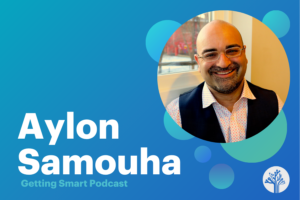OER Curation at Scale: An Opportunity to Support Personalized Learning

By Mark Hannah
As educators, we’re given an opportunity at the beginning of every school year to nurture 30 young minds, each with a unique set of interests and abilities. While we strive to develop curriculum, content and instruction that is as distinct as our learners, the scale of this effort can be as daunting as it is impractical. Much of the practice, process and materials developed in support of personalized learning provides support that makes this practice more attainable.
Rhode Island has recently embarked on an effort to move towards increased personalization for all learners. As part of this project, they’ve developed a document that serves as a blueprint for how they will move forward as a state. Within this document, and as part of the 2017 National Education Technology Plan, personalized learning is defined as:
“A student experience in which the pace of learning and the instructional approach are optimized for the needs of each learner. Standards aligned learning objectives, instructional approaches and instructional content (and its sequencing) may all vary based on learner needs. In addition, learning activities are meaningful and relevant to learners, driven by their interests and often self-initiated.”
Rhode Island’s emphasis on personalized learning underscores the role that policy, tools and content can play to better support educators as they look for ways to deliver the content and instruction best suited for each learner.
While policy and tools lay a necessary foundation for personalized learning, its success hinges on accommodating multiple forms of content that consider each individual learner’s needs. Today, the ever-developing body of open education resources (OER) can deliver on this content requirement when it’s curated at scale, and considers a few key ingredients:
1. Publishers: It’s not uncommon to find large collections of OER that favor a single source of content. It’s the quickest way to scale, but this approach confuses quantity for quality. When collections are created with the belief that diverse methods of delivery, perspectives and approaches matter, there are greater opportunities for personalization.
Publishers like The Academy of Achievement, PhET and Q-files all bring a unique voice that connects with students differently. As the OER community works to equip educators with the tools to effectively prescribe content to learners, it’s important to account for the value of these unique perspectives in how content was authored.
2. Formats: We all learn differently, and today’s students are no exception. Collections that include a broad selection of publishers (e.g. PBS Learning Media, TeachEngineering) typically include a greater diversity of learning resource types. Video, interactive games, activities, text passages or illustrations all connect with different learners in different ways. When this diversity is considered, and tools are available to easily find this content, educators have an opportunity to design instruction based on individual student learning styles.
3. Complexity: Educators who have turned to the open web understand open content is authored at a variety of reading levels with varying degrees of complexity. Collections that account for this include publishers like ReadWorks.org and Scholastic Teachers who use measures such as readability levels, DOKs (depth of knowledge) and grade level for both curation criteria and tagging to provide greater opportunity for locating content that best suits the needs of each learner.
Additionally, to effectively curate and deliver OER at scale, technology providers must consider these important elements:
1. Public Copyright Licenses: Licenses, like those established by Creative Commons, are an important part of understanding how a learning resource can be repurposed and redistributed. Curated collections that store this data help educators understand a resource’s terms of use.
2. Process: The three key processes for curation of OER require that vetting, contextualization and ongoing maintenance all be considered. Curators that apply common standards throughout each curation process ensure consistency and alignment with structures that are meaningful to teachers and learners.
3. Technology and Educators: Effective curation at scale relies on a thoughtful pairing of human expertise and technology, each uniquely suited for a distinct set of tasks. Collections that achieve this balance enforce a level of consistency and accuracy, while still preserving the voice of the teacher responsible for its curation.
4. Delivery: In K-12 today, there is a wide variety of technology available that is positioned to support personalized learning. In order for technology to work well, it must work well together. In all aspects, but for curated OER, technology standards for provisioning access, delivering and integrating learning resources must be a priority for it to be useful for teachers in delivering personalized learning paths to students.
Delivering on the promise of personalized learning using curated OER is here and now. Let’s work together to do something good for students and teachers.
For more, see:
- Vancouver Pilots Comprehensive Open Math Curriculum
- Getting Smart Podcast | The Role of OER in 21st Century Classrooms
- 3 Steps for Educators to Take Advantage of OERs
Mark Hannah is Chief Product Officer at Knovation and a former elementary teacher. Follow Knovation on Twitter: @Knovation
Stay in-the-know with all things EdTech and innovations in learning by signing up to receive the weekly Smart Update.





0 Comments
Leave a Comment
Your email address will not be published. All fields are required.